|
||||||||||||||||||||||
![Home - Air Power Australia Website [Click for more ...]](APA/APA-Title-Main.png) |
||||||||||||||||||||||
![Sukhoi PAK-FA and Flanker Index Page [Click for more ...]](APA/flanker.png) |
![F-35 Joint Strike Fighter Index Page [Click for more ...]](APA/jsf.png) |
![Weapons Technology Index Page [Click for more ...]](APA/weps.png) |
![News and Media Related Material Index Page [Click for more ...]](APA/media.png) |
|||||||||||||||||||
![Surface to Air Missile Systems / Integrated Air Defence Systems Index Page [Click for more ...]](APA/sams-iads.png) |
![Ballistic Missiles and Missile Defence Page [Click for more ...]](APA/msls-bmd.png) |
![Air Power and National Military Strategy Index Page [Click for more ...]](APA/strategy.png) |
![Military Aviation Historical Topics Index Page [Click for more ...]](APA/history.png)
|
![Intelligence, Surveillance and Reconnaissance and Network Centric Warfare Index Page [Click for more ...]](APA/isr-ncw.png) |
![Information Warfare / Operations and Electronic Warfare Index Page [Click for more ...]](APA/iw.png) |
![Systems and Basic Technology Index Page [Click for more ...]](APA/technology.png) |
![Related Links Index Page [Click for more ...]](APA/links.png) |
|||||||||||||||
![Homepage of Australia's First Online Journal Covering Air Power Issues (ISSN 1832-2433) [Click for more ...]](APA/apa-analyses.png) |
||||||||||||||||||||||
| Last Updated: Mon Jan 27 11:18:09 UTC 2014 | ||||||||||||||||||||||
|
||||||||||||||||||||||
|
||||||||||||||||||||||
![Home - Air Power Australia Website [Click for more ...]](APA/APA-Title-Main.png) |
||||||||||||||||||||||
![Sukhoi PAK-FA and Flanker Index Page [Click for more ...]](APA/flanker.png) |
![F-35 Joint Strike Fighter Index Page [Click for more ...]](APA/jsf.png) |
![Weapons Technology Index Page [Click for more ...]](APA/weps.png) |
![News and Media Related Material Index Page [Click for more ...]](APA/media.png) |
|||||||||||||||||||
![Surface to Air Missile Systems / Integrated Air Defence Systems Index Page [Click for more ...]](APA/sams-iads.png) |
![Ballistic Missiles and Missile Defence Page [Click for more ...]](APA/msls-bmd.png) |
![Air Power and National Military Strategy Index Page [Click for more ...]](APA/strategy.png) |
![Military Aviation Historical Topics Index Page [Click for more ...]](APA/history.png)
|
![Intelligence, Surveillance and Reconnaissance and Network Centric Warfare Index Page [Click for more ...]](APA/isr-ncw.png) |
![Information Warfare / Operations and Electronic Warfare Index Page [Click for more ...]](APA/iw.png) |
![Systems and Basic Technology Index Page [Click for more ...]](APA/technology.png) |
![Related Links Index Page [Click for more ...]](APA/links.png) |
|||||||||||||||
![Homepage of Australia's First Online Journal Covering Air Power Issues (ISSN 1832-2433) [Click for more ...]](APA/apa-analyses.png) |
||||||||||||||||||||||
| Last Updated: Mon Jan 27 11:18:09 UTC 2014 | ||||||||||||||||||||||
|
||||||||||||||||||||||
| Quo Vadis - AMRAAM? |
by Carlo Kopp First published in Australian Aviation September, 1986 |
|
Conceived as the ultimate standoff air to air missile the sophisticated and deadly AMRAAM has the distinction of being the subject of political bickering unseen since the sixties' F-111 programme. AMRAAM was developed to fulfill a crucial role in the air defence of the Free World and without viable alternatives the repeatedly threatened cancellation of the programme could have serious long-term implications. AMRAAM is the successor to the Raytheon AIM-7 Sparrow missile family, one of the great disappointments of the Vietnam conflict. The semi active radar guided Sparrow was seen in the early sixties as the ideal all aspect beyond-visual-range (BVR) all weather air to air weapon. Sparrow brought with it the era of missile only armed fighters - the US Navy's primary air defence fighter the F-4B had its weapon system built around Sparrow. In spite of all expectations Sparrow performed poorly in combat. The poor reliability of the vacuum tube guidance system, the limited aerodynamic manoeuvrability, the large minimum lock-on range, the inability of the conically scanning seeker to handle ground clutter and evasive manoeuvring by targets, all contributed to a kill probability (P[k]) of less than 10% per launch. Upgrading the AIM-7E to E-2 configuration improved manoeuvrability and minimum lock-on, range but performance and reliability remained unacceptable. The emerging teen series fighters needed a better missile and the fully solid state AIM-7F was developed to meet this need. The dish antenna was replaced with a conically scanning slotted planar array (see AA Jun 82 p33) and the solid state electronics brought better reliability and signal processing capability. Nevertheless quality control problems emerged and the AIM-7F failed its first Opeval (operational evaluation). General Dynamics were meanwhile brought in as a competitive second source for guidance kits eventually bringing the mean-time-between-failure (MTBF) rate up to 500 + hours. The AIM-7F reached front line units in 1974 and has been the primary armament of the F-14 and F-15 until the 1980 emergence of the monopulse AIM-7M. Many of the basic limitations of the Sparrow are generic to the semi active guidance principle. Once the missile is launched the fighter must illuminate the target with its radar until missile impact which renders it vulnerable to attack and ties up its fire control radar and weapon system. The Sparrow family is further disadvantaged by a bulky 1950s airframe with inherent limitations in manoeuvrability, speed and range. The 5001b all up weight limits usage to larger fighters while the type of guidance has a limited ability to cope with ground clutter, ECM and lock breaking manoeuvres. Although the monopulse Skyflash and AIM-7M are improved in the latter respect the basic obsolescence of the weapon makes it ill suited to a one vs many scenario fought in all weather at lower altitudes. Modern track-while-scan (TWS) fighter radars can deal with multiple targets and to be used to an advantage require a multishot missile. To date only the large, expensive 10001b AIM-54 Phoenix has this capability. Recognising these factors the US DoD initiated the Advanced Medium Range Air Air Missile (AMRAAM) as a Joint USAF/USN programme and established a joint programme office at the USAF Armaments Divsion, Eglin AFB in Florida. AMRAAM was clearly from the beginning an ambitious programme. The new missile would have an all aspect capability against manoeuvring targets in a look down/shoot down and jamming environment. It would offer a multiple launch capability when coupled to a TWS capable fighter while remaining suitable for close in visual attacks in dogfight situations. It would also fit into existing Sparrow wells while being far lighter, longer ranging, faster and more reliable. These capabilities would be coupled to a cost comparable to Sparrow. Such features would allow lightweight air superiority fighters such as the F-16 and F-18A to simultaneously engage and destroy up to six hostilities under BVR conditions while also offering Sidewinder like fire and forget direct launches in dogfights. In December 1976 Ford Aerospace, General Dynamics, Hughes, Raytheon and a Motorola/Northrop team entered competition for the award of validation/demonstration contracts for the eventual two contractor flyoff. Under considerable DoD pressure to minimise programme cost both winning contractors, Raytheon and Hughes, submitted US$40 million fixed price bids each hoping to later recoup an estimated US$50 million in losses. The 33 month contract was awarded in February 1979. The Raytheon weapon employed a rather radical wingless airframe exploiting the weapon's high speed to generate body lift. The Hughes weapon employed a more conservative Sparrowlike airframe layout but utilising tail control fins. The planned 10 launch programme was terminated after 3 launches per contractor with the 50 month US$421 million fixed price full scale development programme contract going to Hughes. Hughes almost certainly exploited their experience from the development of the digital AIM-54C. The ultimate production run could exceed 24,000 rounds/US$10,000 million split at 60%/40% between the prime contractor Hughes and Raytheon who were nominated second source supplier in 1982. IOC for AMRAAM was specified as 1986. The FSD programme soon ran into difficulties which wasn't surprising as the task of building a fully digital pulse doppler look down/shoot down fire control radar into a 43"x4" cavity in a 330 lb missile at a US$200,000 unit cost is anything but trivial. Specific problems had arisen with a producibility per cost and with the cost of test equipment, both attributed by a House Armed Services Committee to the contractor. Industry sources in the US however point to the pressure exerted by the government upon the contractor to submit a very low fixed price bid on an obviously very risky and complex development programme with a compressed time schedule. This may have forced the contractor into making a number of design tradeoffs to cut development cost at the expense of increased production cost. Hughes are committed to built 100 rounds for test and evaluation, at this stage the programme is lagging by 22 months and Hughes are expected to lose US$200 million which may not be recovered in production contracts. The uniquely broad role definition of the AMRAAM reflects in many aspects of the weapon's system design. As no previous weapon in this class has ever been built the designers had few opportunities to draw on previous experience in implementation. The complexity of managing the design effort is illustrated by the use of 41 subcontractors who account for 80% of the production cost of a round. Airframe The airframe of AMRAAM is built of stainless steel to provide maximum structural integrity during high G manoeuvres given substantial airframe heating. Heating is a critical problem due to both the high Mach 4 class speed of the weapon and the power dissipation of the electronics. AMRAAM employs small midbody wings to provide lift and thus enhance controllability at low speeds. Aerodynamic control is provided by battery powered/ electrically actuated cruciform tail surfaces, actuators are built by Lucas Aerospace in the UK. AMRAAM is propelled by a high impulse boost/sustain solid rocket engine built by Hercules. This powerplant provides the high acceleration required for a quick close-in kill while sustaining the round for a maximum range beyond 40nm. The high cruise speed maximises body lift for manoeuvring while also cutting the victim's warning time. Aluminium was removed from the propellant for the very same reason, reducing the visibility of the smoke plume. A 50 lb Chamberlin blast fragmentation warhead is carried fore of the wings, its small size is justified in view of the accuracy of the guidance. AMRAAM fits very neatly into the envelope of a Sparrow but is much lighter at 3351b against 5001b. The missile is built for ejector and rail launch with an AIM-9 compatible launcher being developed. This allows the carriage of 6 rounds on F-16s or F-18As while the larger F-14 and F-15 may carry up to 8 rounds each. AMRAAM will be painted dull grey to reduce visual detectability both during carriage and flight. Guidance The sophisticated and compact guidance system of AMRAAM has been one of the major problem areas in development. The active terminal homing radar seeker is capable of direct launch in fire-and-forget mode at dogfight ranges, while it also operates in command-inertial/inertial/active-terminal-homing mode at standoff ranges. In the latter mode the launch aircraft's fire control radar operates in TWS mode and offers the target no detectable warning of missile launch (unlike semi active guidance where illumination may be detected by the victim). AMRAAM is launched on command-inertial guidance toward the target. The launch aircraft's radar then beams target position updates to a datalink receiver on AMRAAM's tail with each scan of its field of view. Some sources suggest that the low power sidelobes of the antenna radiation pattern are used for this purpose to minimise the chance of detection. The launch aircraft's fire control system then computes and displays the time to go to the point where the target can no longer manoeuvre out of the acquisition 'basket' of AMRAAM's active seeker. At this point updates may cease and AMRAAM may continue on inertial guidance until lock-on range is reached. At that point the active seeker is turned on, the target acquired and terminal homing commences. The relatively short range over which the active seeker is
used minimises the victim's warning time and facilitates burn through
of
any of the victim's ECM which may be activated. This philosophy puts
the
target up against a sophisticated fighter borne fire control radar at
those ranges where manoeuvre or jamming could affect the less capable
missile radar seeker. In this mode up to eight hostlies may be attacked
simultaneously. Air combat simulations have apparently suggested that
degradation of the launch aircraft's TVVS radar performance through
capable ECM will force the launch aircraft to close in for visual
identification and direct firing of AMRAAM with a subsequent P[k] about
twice that of Sparrow. This serves to illustrate the importance of
standoff identification of potential targets.
Radar Seeker AMRAAM's active radar seeker is an impressive piece of engineering. It had undergone substantial design changes many of which resulted from the replacement of a solid state (transistor) transmitter with a travelling wave tube (TWT). One of the most difficult design constraints was the absence of seeker cooling, a lot of the heat dissipated by the electronics during the shod flight to the target accumulates in the seeker causing the internal temperature to surge; this results in high thermal and mechanical stress to many electronic components while also resulting in performance drift in analogue components. Several innovative design features were employed. For instance the radar receiver's RF (radio frequency) processor is sandwiched into the actual slotted planar array antenna. Advanced thin-ffim microwave hybrid integrated circuits were used for this purpose. Placing the RF processor up against its antenna improves seeker sensitivity and accuracy by eliminating signal losses and delays inherent in conventional antenna-receiver feeds. The incoming X-band signals are heterodyned down (a common technique for converting signal bearing microwaves down to a frequency where a conventional radio receiver may process them) to the intermediate frequency (I F) within this stage and then fed via coaxial cable into the missile's body. This technique eliminates all of the microwave 'plumbing' in the receiver reducing weight, cost and complexity. The only plumbing which remains is the transmitter's output feed which is routed through the gimballed joint, it carries the high power microwave pulses to the antenna. The use of a TWT was very conservative but almost certainly due to the inability of the high power microwave transistors to cope with the high thermal stress. The combination of an inherently highly stressed device with high operating temperatures and possibly SWR (standing wave ratio - a measure of how much of the transmitter's output power gets reflected back into the transmitter) problems due to seeker radome mismatch will usually result in a high failure rate. Fitting a TWT would have required major surgery to the power supplies while also increasing weight and battery drain. An interesting feature is the fitting of a motion sensing rate gyro on the back of the antenna, a counterweight is also fitted. The IF signal coming out of the receiver is then fed into an IF stage after which it is digitised and fed into the digital signal processor. The software driven digital signal processor which is built with several large custom hybrid integrated circuits is a specialised form of computer which is the key to AMRAAM's ability to detect targets in clutter (clutter = radar waves reflected off the surface of the earth. The simplest analogy to a look down/shoot down radar finding a low flying target in clutter is that of chasing a moth flying 6" above the lawn at night with a torch...) and defeat jamming or evasive manoeuvring. The processor will filter out the target's return from the background and is flexible enough, under the control of the missile's main processor, to allow for changes in seeker pulse repetition frequency (PRF) as target aspect changes. Though never openly stated, AMRAAM is likely to use many of the processing algorithms developed for the C model Phoenix, these are reputedly able to defeat the beam turn, a favourite evasive manoeuvre which breaks lock on Doppler radars by rapidly changing both the Doppler and the strength of the reflected return (the latter is termed scintillation; an aircraft reflects different amounts of microwave energy from different angles). The signal processor, IF stages, frequency synthesizer, transmitter, antenna/RF-processor and antenna pointing/ stabilising subsystems which together comprise the radar are under the control of the general missile processor. Implemented with a 30MHz class microprocessor this unit handles radar operation, datalink control, missile navigation, autopilot functions, adaptive fusing and self test functions. The software running on this processor controls the flight of AMRAAM, switching between guidance modes and ultimately playing AMRAAM's multimode radar against the target's manoeuvres and jamming. Developing this software was a major exercise; in the project validation phase 27,000 lines of assembly language code were written though it is expected that production weapons may require up to 80,000 lines of code (at 66 lines/page that is 1,200 pages of software). Much of AMRAAM's capability depends on the quality of the software which will certainly be upgraded with time to defeat newer threats and countermeasures. The configuration of the guidance system built up of networked processors is inherently flexible which keeps an opponent guessing as to what he is up against. The missile processor receives precise position references from a Northrop strapdown three axis inertial reference unit which contains gyros and accelerometers to sense airframe motion. Steering commands computed by the processor are then passed to the tail control actuators through a coaxial cable running along the outside of the solid rocket. Performance Full scale development flight tests of AMRAAM have been up to the time of writing very successful with four kills out of four guided launches. AMRAAM has been tested in fire-and-forget mode against non-manoeuvring and manoeuvring targets at transonic speeds, it has successfully flown under datalink control at maximum range at high altitude and has also successfully destroyed a low flying drone at 1,000ft/MO.7 in a tail aspect look down/shoot down attack from 16,000ft. Programme Officials have stated that the weapon has either met or exceeded specifications in the areas of range, kill probability, look down/ shoot down performance, acquisition, multiple target capability, time to upload on launch aircraft and reliability. Deficiencies have been observed but these have been described as minor eg a slightly longer launch-to-eject time after trigger depression.
Production cost on the other hand has been described as high. When AMRAAM was conceived in 1978 it was estimated at US$68,000. Currently it stands at US$166,000 in 1978 dollars. This has understandably provided legislators with limitless ammunition to assault the programme with, though it is unlikely that any alternatives exist. Cost reduction by introducing modifications to the design, eg replacing the hybrid circuits with cheaper VLSINHSIC monolithic circuits, using a cheaper inertial unit, removing one of the control fin batteries and implementine various detail changes would save only about 9% of the unit cost" Other options such as upgrading Sparrow seem to lose sight or the airframe limitations and additional development lag to be incurred. At this stage the first production lot of 260 rounds funded in the 1987 DoD budget are split 60/40 between Hughes and Raytheon, Raytheon are expected to be competitive by the third lot. Legislators argue that in spite of this the cost will be above USAF estimates of US$300,000+/unit in 1986 dollars, substantially more than the US$171,000/unit for AIM-7M. Supporters of the programme argue that a substantial investment at this stage to improve the mass producibility of the weapon would solve the problem, though in the light of some investigations it may be somewhat optimistic. Both the USN and TAC are committed to AMRAAM which is deemed to be critical in bringing the F-16 up to date in the European theatre and arming the ATF, the Stealth fighter and F-15 against the expected rapid build up of Fulcrum and Flanker. Later versions of AMRAAM are to possess features such as passive homing in addition to existing home-on-jam capability and promise to be major force multipliers. The AIM-120A AMRAAM is a highly capable weapon with a
flexibility of application unique to the new class of weapon it
represents. The penalty is complexity with associated cost, factors
which should be weighed against its capabilities rather than blindly
comparing dollar costs against mature developments of fifties
technology, In the world of high technology one seldom gets more than
one has paid for and the instance of AMRAAM clearly demonstrates that
the cheapest solution need not always be the cheapest solution.
|
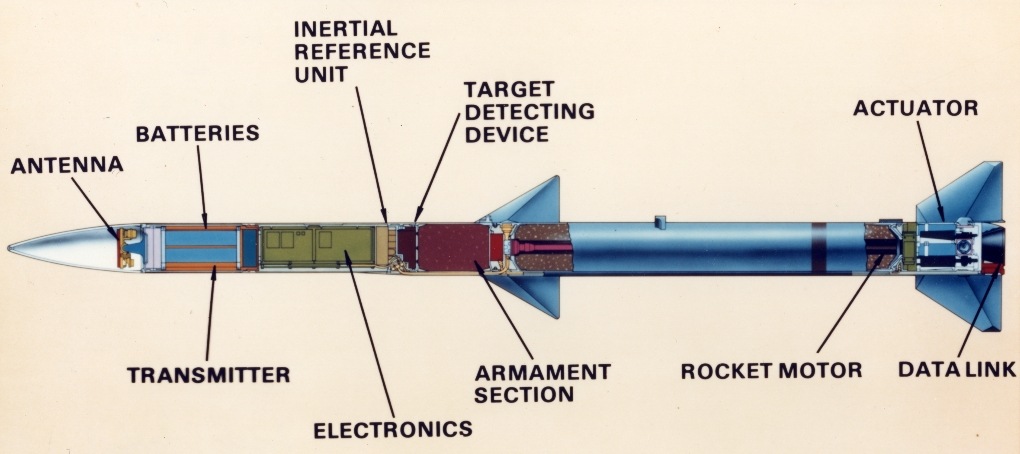 |
| AIM-120
cutaway diagram (Hughes diagram) |
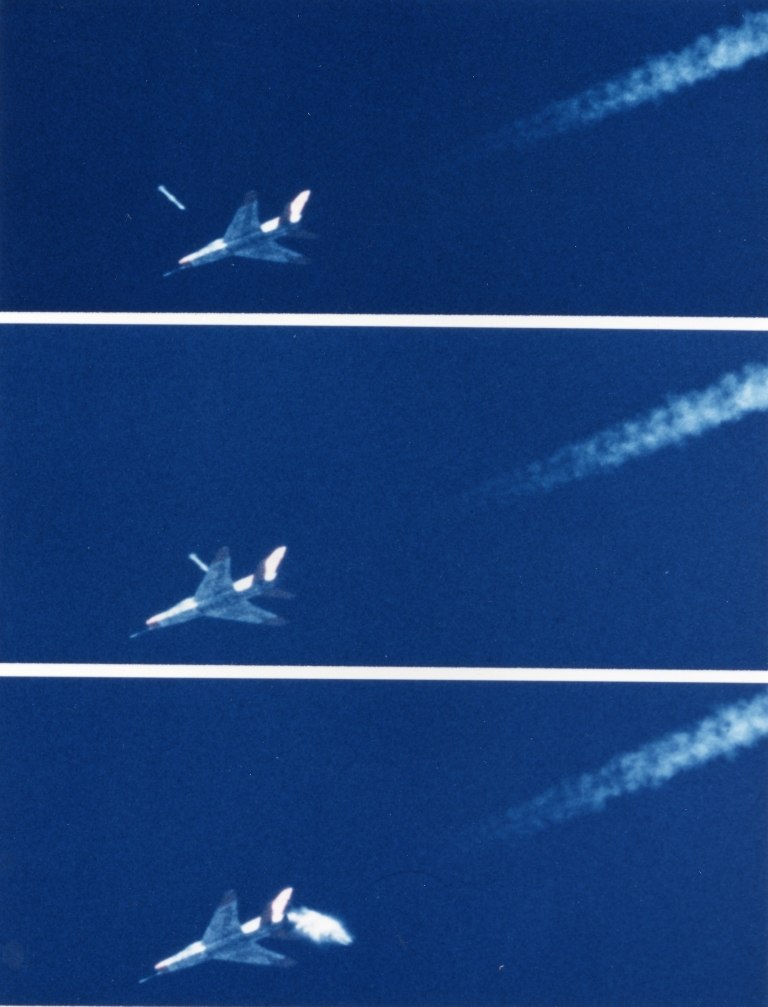 |
|
Developmental
AIM-120A round destroys a QF-100 drone (U.S. Air Force photo)
Below QF-102 shot.
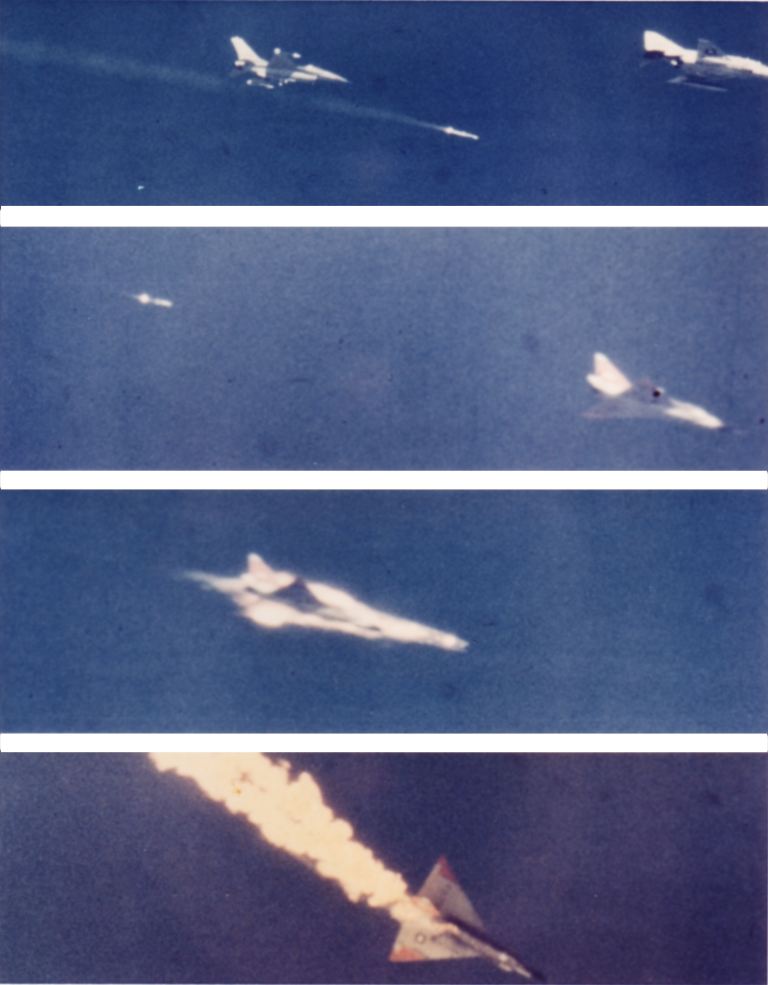 |
 |
Developmental AIM-120A antenna assembly (Hughes Aircraft Company photo) Below developmental AIM-120A ECU module, EU cardcage, processor board and IMU. |
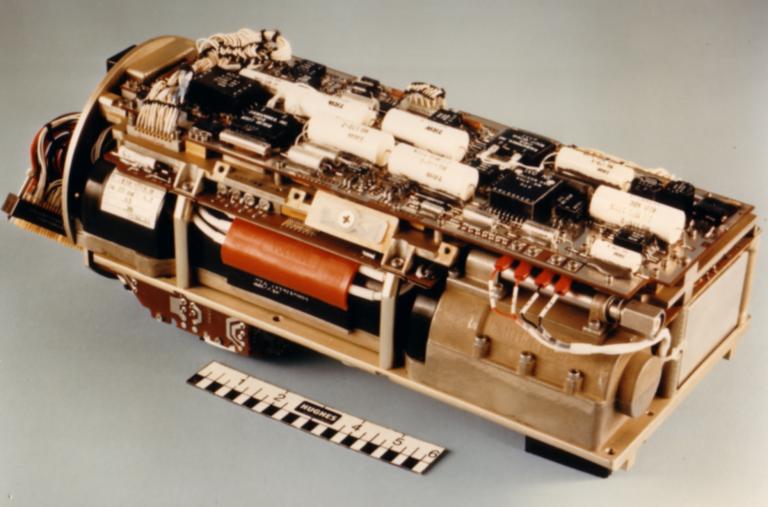 |
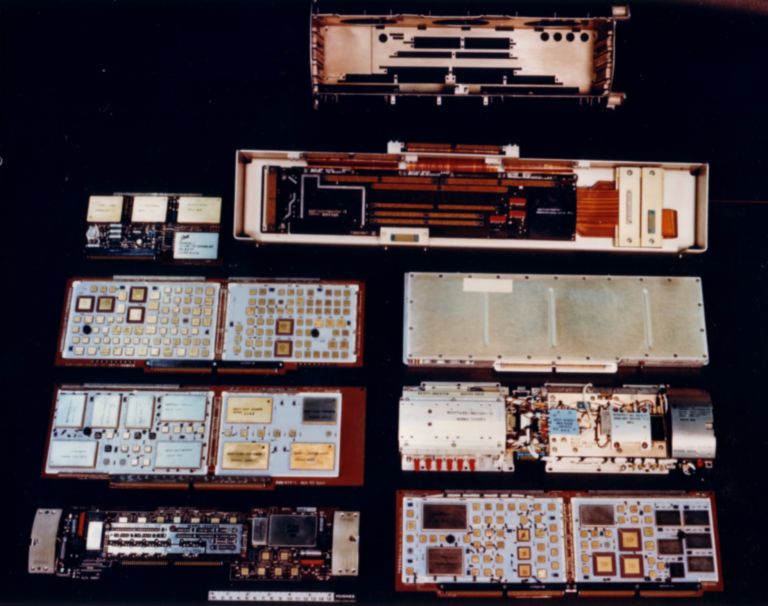 |
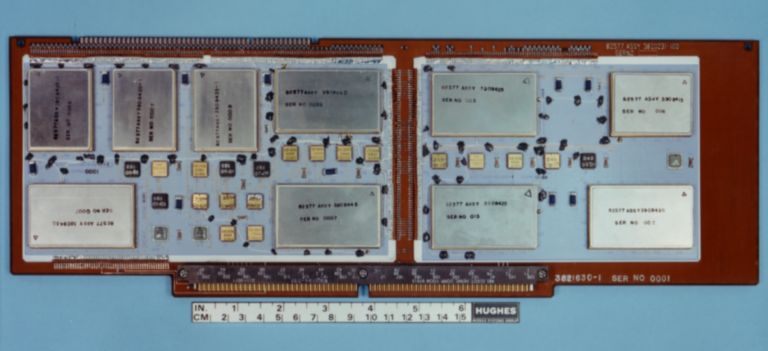 |
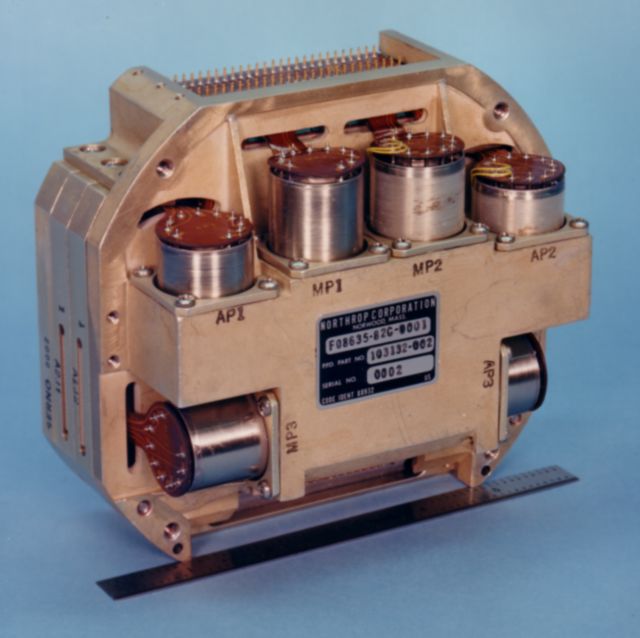 |
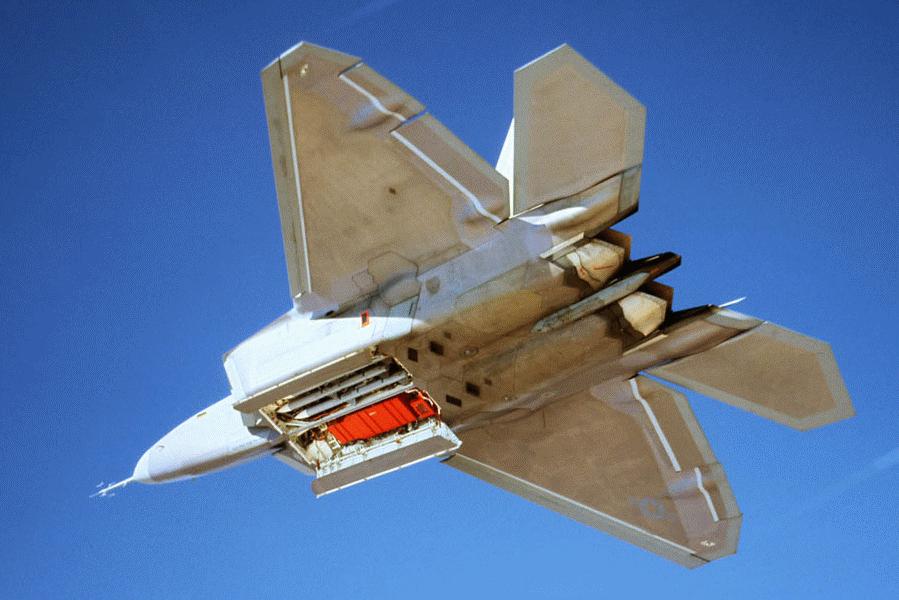 |
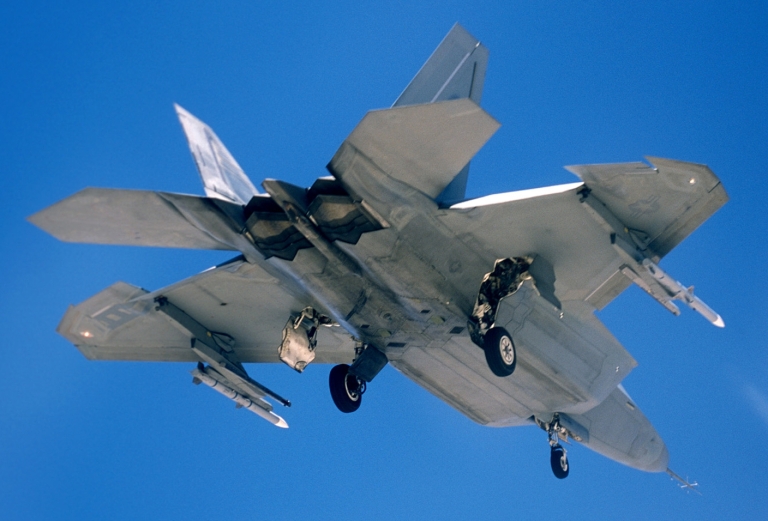 |
The new F-22A carries up to six internal AIM-120C rounds in its main internal bays, and up to four external rounds (U.S. Air Force) |
|
|||||||||||||
![Sukhoi PAK-FA and Flanker Index Page [Click for more ...]](APA/flanker.png) |
![F-35 Joint Strike Fighter Index Page [Click for more ...]](APA/jsf.png) |
![Weapons Technology Index Page [Click for more ...]](APA/weps.png) |
![News and Media Related Material Index Page [Click for more ...]](APA/media.png) |
||||||||||
![Surface to Air Missile Systems / Integrated Air Defence Systems Index Page [Click for more ...]](APA/sams-iads.png) |
![Ballistic Missiles and Missile Defence Page [Click for more ...]](APA/msls-bmd.png) |
![Air Power and National Military Strategy Index Page [Click for more ...]](APA/strategy.png) |
![Military Aviation Historical Topics Index Page [Click for more ...]](APA/history.png)
|
![Information Warfare / Operations and Electronic Warfare Index Page [Click for more ...]](APA/iw.png) |
![Systems and Basic Technology Index Page [Click for more ...]](APA/technology.png) |
![Related Links Index Page [Click for more ...]](APA/links.png) |
|||||||
![Homepage of Australia's First Online Journal Covering Air Power Issues (ISSN 1832-2433) [Click for more ...]](APA/apa-analyses.png) |
|||||||||||||
| Artwork, graphic design, layout and text © 2004 - 2014 Carlo Kopp; Text © 2004 - 2014 Peter Goon; All rights reserved. Recommended browsers. Contact webmaster. Site navigation hints. Current hot topics. | |||||||||||||
|
Site Update
Status:
$Revision: 1.753 $
Site History: Notices
and
Updates / NLA Pandora Archive
|
|||||||||||||
|
|
Tweet | Follow @APA_Updates | |||||||||||
|
|
|||||||||||||
|
|
|||||||||||||